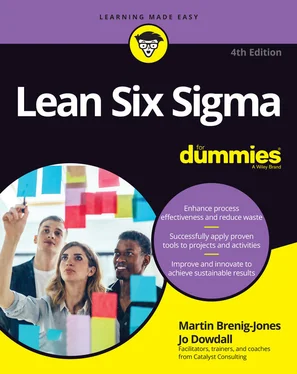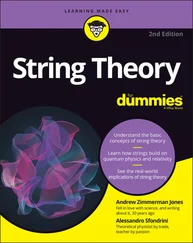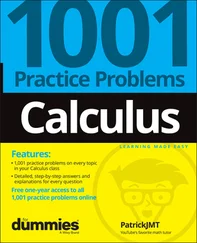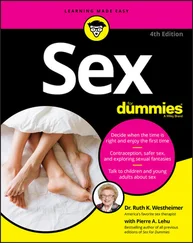10 Part 6: The Part of Tens Chapter 21: Ten Tips for Best-Practice Project Storyboards Keep It Brief Make It Visual Make It Flow Weave the Story Together with a Golden Thread Keep It Up to Date as You Go Along Don't Forget the “Happily Ever After” Part Keep It Simple Develop a One-Page Summary Reflect on the Lessons Learned Share, Share, Share! Chapter 22: Ten Pitfalls to Avoid Jumping to Solutions Coming Down with Analysis Paralysis Falling into Common Project Traps Stifling the Program Before You’ve Started Ignoring Change Management Getting Complacent Thinking That You’re Already Doing It Believing the Myths Doing the Wrong Things Right Overtraining Chapter 23: Ten (Plus One) Places to Go for Help Your Colleagues Your Sponsor Other Organizations The Internet Social Media Networks and Associations Conferences Books Periodicals Software Training and Consulting Companies
11 Index
12 About the Authors
13 Connect with Dummies
14 End User License Agreement
1 Chapter 4 TABLE 4-1 Researching the Requirements TABLE 4-2 Pros and Cons of Customer SurveysTABLE 4-3 Some Common CTQs
2 Chapter 10TABLE 10-1 A Value-Add AnalysisTABLE 10-2 A Waste Walk
3 Chapter 13TABLE 13-1 Weighing up the risk
4 Chapter 15TABLE 15-1 DMADV and Design ThinkingTABLE 15-2 What Is a Prototype?
1 Chapter 1FIGURE 1-1: The TPS house. FIGURE 1-2: Histogram showing the time taken to process orders. FIGURE 1-3: Standard deviation. FIGURE 1-4: Standard deviation formula. FIGURE 1-5: Highlighting defects. FIGURE 1-6: Abridged Process Sigma conversion table. FIGURE 1-7: Calculating Process Sigma values.
2 Chapter 2FIGURE 2-1: The five phases of DMAIC. FIGURE 2-2: A sample improvement charter. FIGURE 2-3: Framing the scope of your improvement project.
3 Chapter 3FIGURE 3-1: Using a process model. FIGURE 3-2: Identifying your internal customers. FIGURE 3-3: Process levels. FIGURE 3-4: The SIPOC model. FIGURE 3-5: Building up the SIPOC model.
4 Chapter 4FIGURE 4-1: Can you Kano? You must know the must-be requirements. FIGURE 4-2: Determining the CTQs. FIGURE 4-3: Developing a CTQ tree. FIGURE 4-4: Paired comparisons: Do you prefer this or that?
5 Chapter 5FIGURE 5-1: A spaghetti diagram. FIGURE 5-2: Keeping it simple with process mapping symbols. FIGURE 5-3: Which route do we follow? FIGURE 5-4: The deployment flowchart. FIGURE 5-5: Highlighting the interfaces. FIGURE 5-6: Measuring time. FIGURE 5-7: Total time showing dead time experienced by customers. FIGURE 5-8: Part of a Value Stream Map. FIGURE 5-9: Value Stream Map conventions. FIGURE 5-10: Identifying the delays. FIGURE 5-11: The ABC order process as a Value Stream Map. FIGURE 5-12: Building up the Value Stream Map. FIGURE 5-13: Developing the picture. FIGURE 5-14: Collecting data. FIGURE 5-15: Looking at the interfaces. FIGURE 5-16: So what’s the time? FIGURE 5-17: Process mapping and data may help highlight the opportunities for ...FIGURE 5-18: A future state map.
6 Chapter 6FIGURE 6-1: A forcefield diagram. FIGURE 6-2: Stakeholder analysis. FIGURE 6-3: Change reaction. FIGURE 6-4: The Golden Circle shows how our communications messages should work...FIGURE 6-5: Elements of change model. FIGURE 6-6: Chart to assess team progress.
7 Chapter 7FIGURE 7-1: Getting the measure of the CTQs. FIGURE 7-2: Matching the voices of the customer and the process. FIGURE 7-3: The different variables will all need corresponding measures to hel...FIGURE 7-4: Bringing the CTQs into the mix. FIGURE 7-5: Checking out the measurement system. FIGURE 7-6: Attribute data in action. FIGURE 7-7: Making inferences. FIGURE 7-8: Understanding the segmentation factors is vital. FIGURE 7-9: Using a systematic approach. FIGURE 7-10: Subgroup sampling from a process. FIGURE 7-11: Formula for Continuous Data. FIGURE 7-12: The formula in practice. FIGURE 7-13: Formula for discrete data. FIGURE 7-14: Precision is a key factor in sample size. FIGURE 7-15: Adjusting the sample size. FIGURE 7-16: Bringing the sample size down. FIGURE 7-17: Precisely what can we afford? FIGURE 7-18: Checking out the check sheet. FIGURE 7-19: Coming up to scratch with the concentration diagram. FIGURE 7-20: Pulling the data collection plan together.
8 Chapter 8FIGURE 8-1: A typical data set that doesn’t reveal very much. FIGURE 8-2: Presenting data as a run chart. FIGURE 8-3: Control chart for a process exhibiting natural variation. FIGURE 8-4: Occurrence of a special cause outside a control limit. FIGURE 8-5: New control limits set after a process review and improvement actio...FIGURE 8-6: Determining the moving range. FIGURE 8-7: Looking at the formula for the X moving R chart. FIGURE 8-8: The four states of a process. FIGURE 8-9: Taking your driving theory test. FIGURE 8-10: The driving needs improvement. FIGURE 8-11: The capability formula. FIGURE 8-12: Location, location, location. FIGURE 8-13: An example histogram. FIGURE 8-14: Looking at a long tail. FIGURE 8-15: Twin peaks. FIGURE 8-16: Looking at the vital few with Pareto.
9 Chapter 9FIGURE 9-1: The fishbone diagram. FIGURE 9-2: Creating an affinity diagram. FIGURE 9-3: The fishbone diagram meets the interrelationship diagram. FIGURE 9-4: Identifying the key drivers. FIGURE 9-5: Demonstrating correlation with a scatter plot. FIGURE 9-6: Working out the line of best fit. FIGURE 9-7: Looking out for thresholds. FIGURE 9-8: Bringing home the baby.FIGURE 9-9: Sometimes the difference is clear. FIGURE 9-10: Being logical.
10 Chapter 10FIGURE 10-1: Mapping the rework loops.
11 Chapter 11FIGURE 11-1: Working on the chain gang. FIGURE 11-2: Brian the Bottleneck. FIGURE 11-3: Banging the drum for drum, buffer, rope. FIGURE 11-4: The benefit of cells. FIGURE 11-5: Keeping it in the family. FIGURE 11-6: Calculating takt time. FIGURE 11-7: Visualizing cycle time versus takt time. FIGURE 11-8: Balancing the flow.
12 Chapter 12FIGURE 12-1: A template for brainwriting. FIGURE 12-2: Multivoting in action. FIGURE 12-3: A criteria selection matrix.
13 Chapter 13FIGURE 13-1: Weighing up the risk with FMEA. FIGURE 13-2: Square pegs and round holes: Contact error proofing. FIGURE 13-3: A shadow board helps you see at a glance if any tools are missing....FIGURE 13-4: Keeping a process performance review meeting tightly focused. FIGURE 13-5: An activity board approach to team management.
14 Chapter 14FIGURE 14-1: The DMADV phases. FIGURE 14-2: A sample design scorecard. FIGURE 14-3: Choosing between DMAIC and DMADV. FIGURE 14-4: The House of Quality. FIGURE 14-5: Seven rooms with a view. FIGURE 14-6: Competition comparison. FIGURE 14-7: The relationship matrix. FIGURE 14-8: Grading performance. FIGURE 14-9: Assessing the impact of measures on customer CTQs. FIGURE 14-10: Developing more Houses of Quality. FIGURE 14-11: The Pugh Matrix.
15 Chapter 15FIGURE 15-1: The double diamonds of Design Thinking. FIGURE 15-2: The persona map. FIGURE 15-3: An empathy map. FIGURE 15-4: The “how might we?” template. FIGURE 15-5: The experiment grid.
16 Chapter 16FIGURE 16-1: The scrum. FIGURE 16-2: The T-shaped person. FIGURE 16-3: The user story card. FIGURE 16-4: A simple Agile kanban board.
17 Chapter 17FIGURE 17-1: A typical outline Rapid Improvement Event Plan. FIGURE 17-2: An example A3.
18 Chapter 18FIGURE 18-1: The Process Management Chart includes essential process informatio...FIGURE 18-2: A template to support Leader Standard Work. FIGURE 18-3: The cultural web is essentially “the way we do things around here....
19 Chapter 19FIGURE 19-1: Successful deployment. FIGURE 19-2: Applying Lean Six Sigma to processes. FIGURE 19-3: So many options to choose from! FIGURE 19-4: Three steps to project selection. FIGURE 19-5: Identifying where suggestions come from. FIGURE 19-6: A list of criteria for assessing project viability. FIGURE 19-7: Benefit-effort matrix for screening projects. FIGURE 19-8: Being business wise with the business Ys.
Читать дальше












